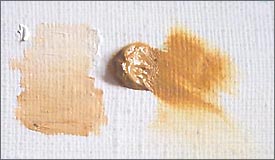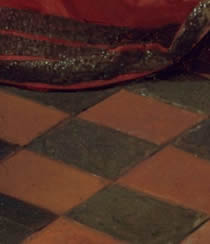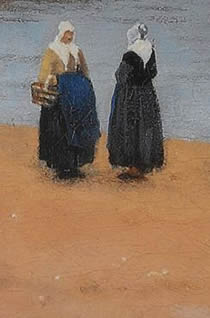
Origin, History and Characteristics
(Gelber Ock, ocre jaune, ocra gialla)
Yellow ocher is a natural earth pigment which consists mostly of clay colored by iron oxides. The earth colors, ranging from yellow ochre to the deepest brown tints, were the most workable and cheapst pigments and, therefore, the most frequently used.
Ochre comes in a great variety of shades depending on its origin. Lighter shades of a pale yellow may be burned to produce darker red shades. The purest ochers come from France and Cyprus. Under moderate heat, yellowish-red colors are produced; however, the stronger the heat, the more rich and saturated the color produced. It can be safely mixed with other pigments.
Ochres vary widely in transparency; some are quite opaque, while others are valued for their use as glazes. Ochre was generally not strong enough to color key parts of compositions, but mixed with other colors it produces a great variety of useful natural tones. Mixed with lead white the broken tone of yellow ocher approximates very closely the color of subtle tones of illuminated flesh tones. Vermilion or madder lake was added when a warmer tone was needed.

Much like its sister color red ochre, yellow ochre first appeared in prehistoric cave paintings in various locations all around the world. The famous cave paintings of Lascaux from over 17,000 years ago (fig. 1) are a prime example, portraying wild animals with tones of yellow. In works of art, women’s skin was often painted yellow, contrasting with the red ochre coloring of men. Yellow ochre also frequently appeared in the regalia and royal costumes of Pharaohs. In works of art women’s skin was often painted yellow, in contrast with men’s red ochre colouring while yellow ochre often appeared in the regalia and royal costumes of Pharaohs. Rosie Lesson, "Yellow Ochre: The Radiance of the Sun." The Thread. 2020. Accessed October 28, 2023.
Yellow Ocher in Vermeer's Painting

Johannes Vermeer
c. 1662–1665
Oil on canvas, 55 x 45 cm.
Staatliche Museen Preußischer Kulturbesitz, Gemäldegalerie, Berlin
Much like most every European painter, Vermeer made extensive use of yellow ocher. He made limited use of it in of his flesh tones, but "interestingly, no red pigment can be discerned in the surface paint layer of the flesh tones of the Woman with a Pearl Necklace (fig. 2); there are various mixtures of yellow ocher, white lead and even black very well blended into one another."Nicola Costaras, "A Study of the Materials and Techniques of Johannes Vermeer," in Vermeer Studies, eds. Ivan Gaskell and Michiel Jonker (New Haven and London: Yale University Press, 1998), 159. Vermeer's flesh tones appear at times rather dull when compared to those of his contemporaries. The brilliant rosy cheeks and lips of the young women so beloved by genre painters, are almost entirely absent in Vermeer's faces. This may be due to an artistic choice or to the fact that he may have used only minimal quantities some red pigment which have faded.
Vermeer used yellow ocher unmixed to portray objects of similar local color such as the floor tiles in The Girl with a Wine Glass (fig. 3). Yellow ocher lightened with lead white was used to render the foreground bank of the View of Delft (fig. 4). Yellow ocher has been detected in the map on the background wall in the Young Woman with a Water Pitcher and yellow parts of the Turkish carpets that are frequently seen in Vermeer's interiors.

Johannes Vermeer
c. 1658–16610
Oil on canvas, 65 x 77 cm.
Staatliche Museen Preußischer Kulturbesitz,
Gemäldegalerie, Berlin

Johannes Vermeer
c. 1660–1663
Oil on canvas, 98.5 x 117.5 cm.
Mauritshuis, The Hague